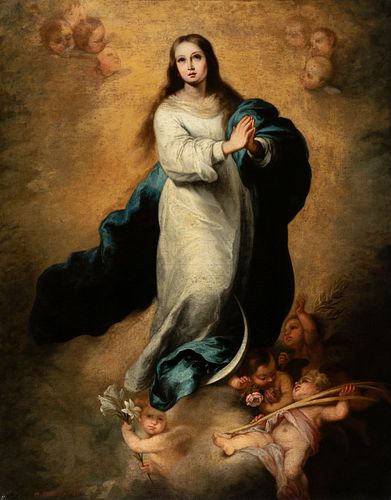Andalusian school of the seventeenth century. Workshop of BARTOLOMÉ ESTEBAN MURILLO (Seville, 1617 - Cadiz, 1682). "Immaculate". Oil on canvas.
Lot 90
About Seller
Setdart Auction House
Carrer Aragó 346
Barcelona
Spain
Setdart Subastas was born in 2004 and is currently the first online art auction in Spain with solidity, prestige and reliability guaranteed by our more than 60,000 users. Setdart has a young, dynamic and enterprising team ready to successfully manage the purchase and sale of art works through custom...Read more
Estimate:
EUR€12,000 - EUR€15,000
$12,903.23 - $16,129.03
Absentee vs Live bid
Two ways to bid:
- Leave a max absentee bid and the platform will bid on your behalf up to your maximum bid during the live auction.
- Bid live during the auction and your bids will be submitted real-time to the auctioneer.
Bid Increments
| Price | Bid Increment |
|---|---|
| EUR€0 | EUR€10 |
| EUR€200 | EUR€25 |
| EUR€500 | EUR€50 |
| EUR€1,000 | EUR€100 |
| EUR€3,000 | EUR€200 |
| EUR€5,000 | EUR€500 |
| EUR€10,000 | EUR€1,000 |
| EUR€20,000 | EUR€2,000 |
| EUR€50,000 | EUR€5,000 |
About Auction
By Setdart Auction House
Oct 20, 2021
Set Reminder
2021-10-20 07:30:00
2021-10-20 07:30:00
America/New_York
Bidsquare
Bidsquare : OLD MASTERS
https://www.bidsquare.com/auctions/setdart-auction-house/old-masters-7700
Setdart Auction House sofia@setdart.com
Setdart Auction House sofia@setdart.com
- Lot Description
Andalusian school of the seventeenth century. Workshop of BARTOLOMÉ ESTEBAN MURILLO (Seville, 1617 - Cadiz, 1682). "Immaculate". Oil on canvas. Size: 97 x 76 cm; 121 x 100 cm (frame). We are in front of a canvas directly inspired by "La Inmaculada del Escorial", an oil painting by Bartolomé Esteban Murillo between 1660 and 1665, today housed in the Prado Museum. The Sevillian master was inspired by a young maiden whose figure centers the canvas, with her body slightly turned, her hands crossed over her heart and her gaze raised. The entire Immaculate rises above a lunar crescent and is accompanied by several child angels, who appear both below her and in the upper corners, surrounding the break of Glory that surrounds the Virgin with golden light. The angels at her feet carry lilies, roses and a palm leaf, Marian symbols taken from the litanies. In the last decades of the 17th century, the emotional, sweet and delicate sentimentality of Murillo prevailed in Seville over the more dramatic one of Valdés Leal, and hence the predominance of his influence in the following century. However, as time progresses, we will find an increasingly superficial influence, which focuses on the imitation of models and compositions, but leaving aside its plastic language, in favor of formulas more typical of the new century. The theme of the Immaculate Conception, very frequent in Spanish art, came to constitute one of the signs of national identity of Spain as a Catholic country. It is one of the most genuinely local themes of Spanish Baroque painting, since our country was the main defender of this mystery, and the one that fought most insistently to make it a dogma of faith. In this context, numerous artists and intellectuals worked to build a clear iconography that would help to spread the Immaculate Conception, bringing together symbolism and popular fervor. Little is known about Murillo's childhood and youth, except that he lost his father in 1627 and his mother in 1628, which is why he was taken under the tutelage of his brother-in-law. Around 1635 he must have begun his apprenticeship as a painter, very possibly with Juan del Castillo, who was married to a cousin of his. This working and artistic relationship would last about six years, as was customary at the time. After his marriage, in 1645, he began what was to be a brilliant career that progressively made him the most famous and sought-after painter in Seville. The only recorded trip he made is documented in 1658, the year in which Murillo was in Madrid for several months. It may be thought that at the court he maintained contact with the painters who resided there, such as Velázquez, Zurbarán and Cano, and that he had access to the collection of paintings in the Royal Palace, a magnificent subject of study for all those artists who passed through the court. Despite the few documentary references regarding his mature years, we know that he enjoyed a comfortable life, which allowed him to maintain a high standard of living and several apprentices. Having become the first painter of the city, surpassing in fame even Zurbarán, moved his will to raise the artistic level of local painting.
- Shipping Info
-
In-house shipping available. Please inquire at admin@setdart.com.
-
- Buyer's Premium



 EUR
EUR CAD
CAD AUD
AUD GBP
GBP MXN
MXN HKD
HKD CNY
CNY MYR
MYR SEK
SEK SGD
SGD CHF
CHF THB
THB













